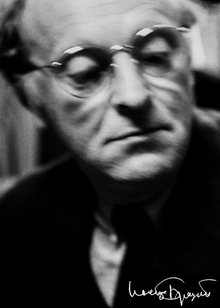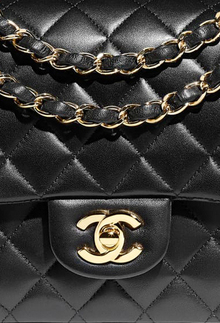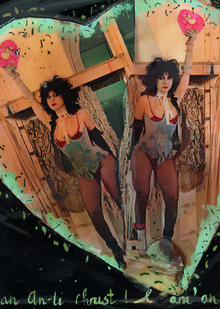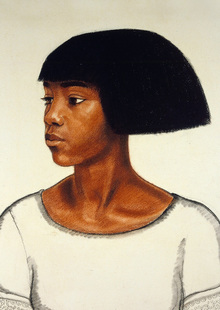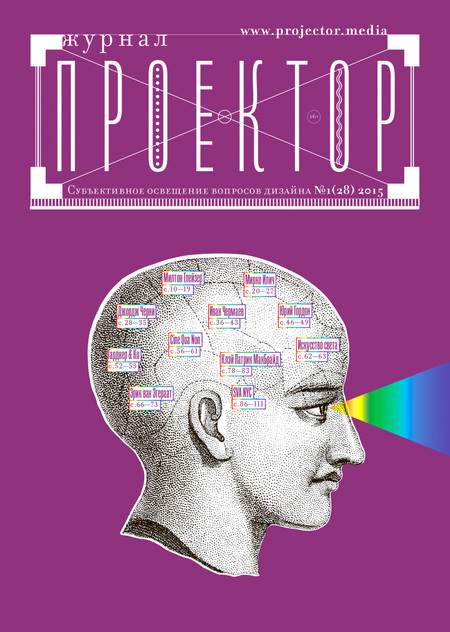
«Projector» magazine. Issue #28
Most publications of this Projector are dedicated to New York School of Visual Arts and the newly opened exhibition Underground Images I curate in the Novy Museum. But first things first!
When my New York colleagues dropped me the list of designers ready for an interview, I was stunned — Milton Glaser, Mirko Ilić, George Tscherny, Ivan Chermayeff, Stefan Sagmeister, Clay Patrick McBride! It felt like an opportunuty to talk to Leonardo da Vinci. Naturally, I talked to them all. I had a long interview with Sagmeister back in 2012 (see «Projector» #21). Three years later, the issue opens with a talk to Milton Glaser. We spent almost an hour discussing the job. Milton is a wise and incredibly emphatic person.
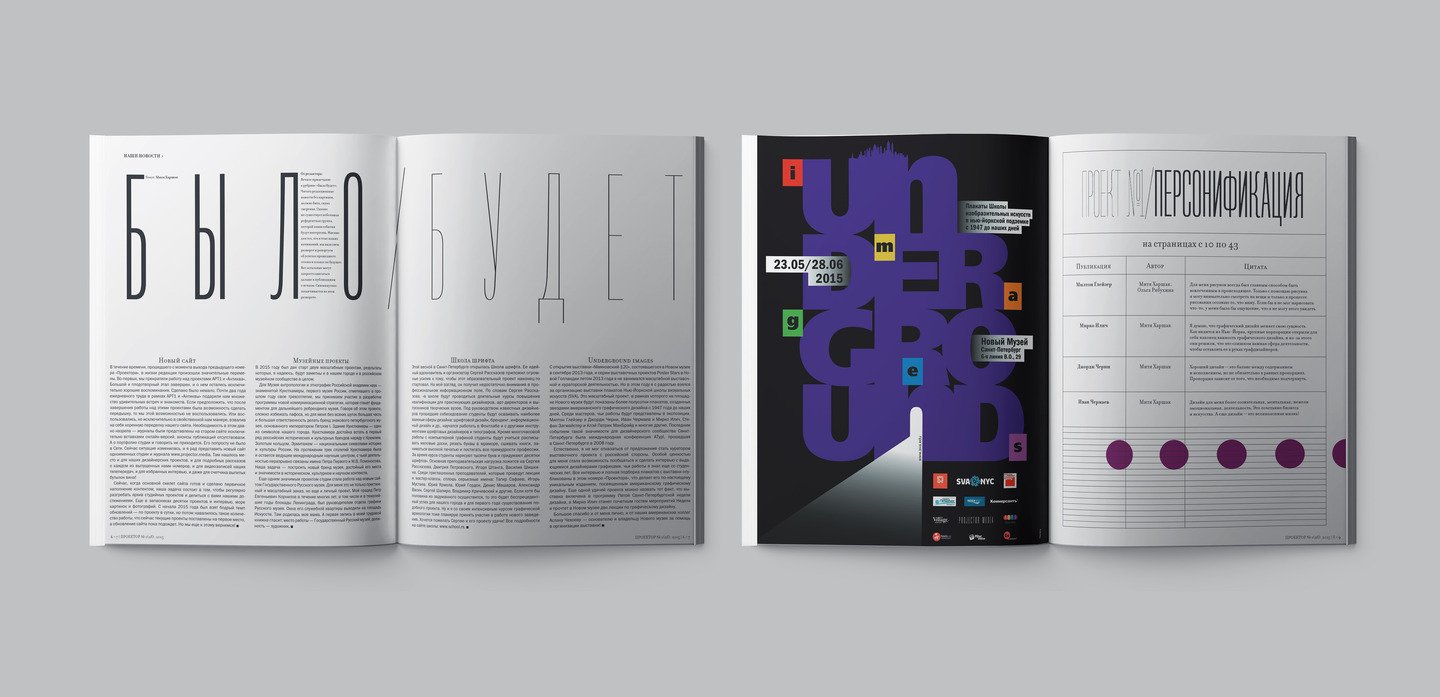
Milton Glaser: «For me, there’s nothing better than sitting at my desk and drawing, designing an object, or pondering over something. This is my life. Making things is what I’m living for. The idea of a traditional beach holiday on a sling-chair terrifies me to death. I’d prefer a jail term or whatever else to avoid this. My job is something crucial and really pleasant to me. I’m in love with the fact that the images in my head may be materialised. This is the same as being God (although God might not like it). It’s a blessing to be doing something you could hardly imagine, and seeing it come true. When my wife needs a break, we go to the countryside. However, I keep working there, too».
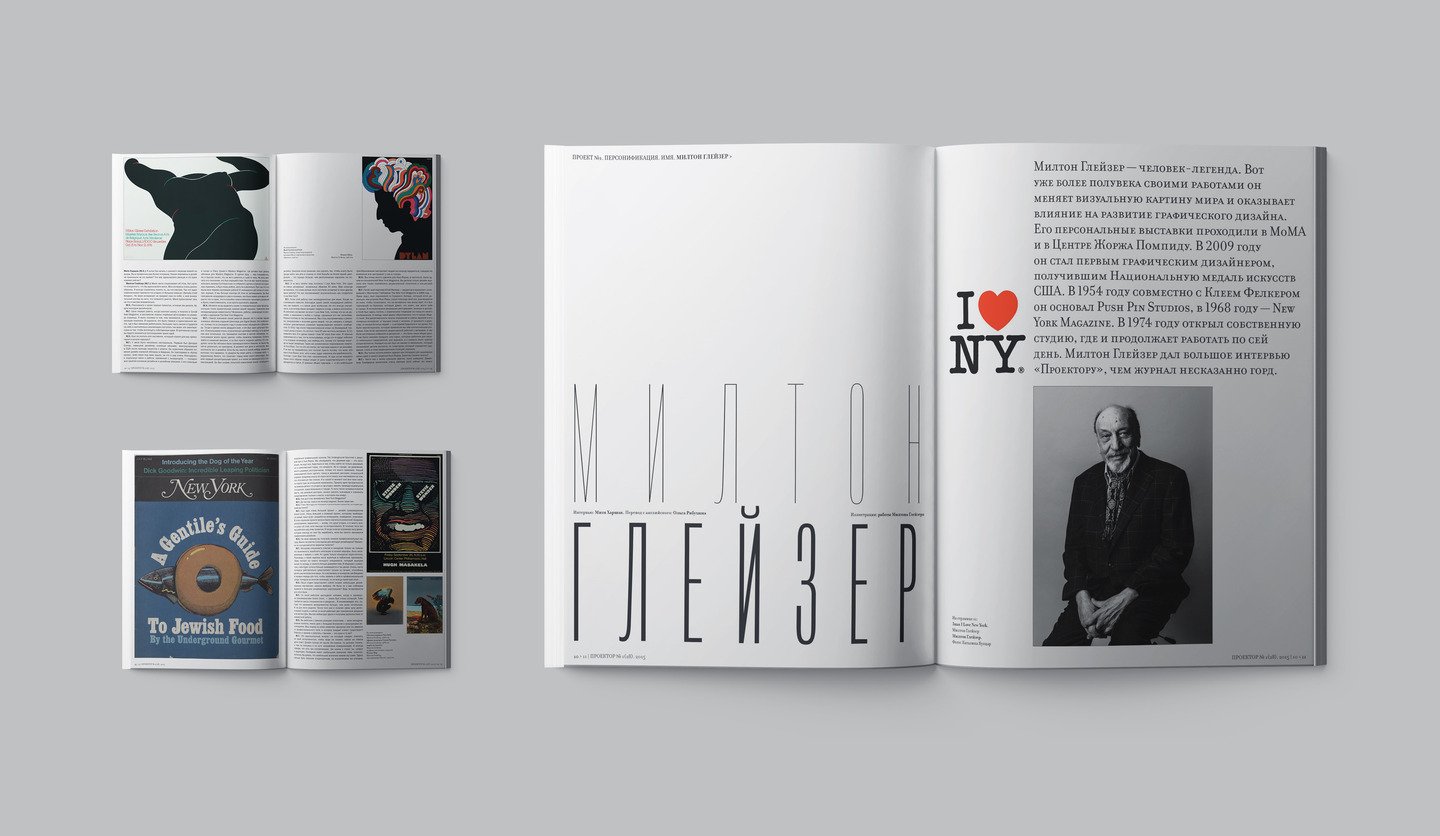
Next, Mirko Ilić, a designer, an illustrator, the former art-director of Time and The New-York Times. Mirko came to St.Petersburg to open the exhibition, and had two rousing lectures in the Novy Museum. «I would take a boring project if I were offered good money, because this is the only way to do an interesting job for someone who is moneyless. This is when you act as Robin Hood — take from the rich and give to the poor. Assumably, everyone does this to a certain extent. My company does about a third of all works for free — on a voluntary basis, which is obviously funded by the other two thirds of commissions we get. This is our mixed blessing, as sometimes the boring tasks turn out to be better than something seemingly interesting from a creative point of view», — says Mirko.
George Tscherny is the forefather of graphic design. I believe every possible Graphic Design Hall of Fame has a plaque with his name. George is in his nineties, but he keeps actively working in his New York studio. This is what he told me: «A good design is the balance between what you do and how you do it, not necessarily in equal proportions — they depend on what you need to emphasize. In a perfect world, I ponder over an idea if I have time for that. I never start the design process until I feel I have the right solution. When sometimes it works out in a different way, I get back to thinking over it. I don’t make many sketches. As a result, when the project is done, I will hardly remember where the idea came from».
Another designer of that generation I had a chance to talk to is Ivan Chermayeff. As a student at Berlin School of Arts, I did my term thesis on his works in the end of the nineties: Early Abstract Identity in the 1960s. And here in this issue Ivan Chermayeff is talking about his life and job foundations: «I’d say design is more of a mental and cognitive rather than emotional activity for me. This is a combination of business and art. Also, design means a great life! The designers who largely influenced me are: Paul Rand, Alvin Eisenmann, Ikko Tanaka, Pierre Mandel, such artists as Picasso and Miró. As for my contemporaries, I believe Massimo Vignelli and Tony Palladino are those who influenced graphic design a lot».
To continue on American design, here’s our permanent contributor Pavel Ulyanov, the expert on the design history of the XX century with the story of the furniture studio Gardner & Co: «Between the two world wars the furniture of bent plywood made a breakthrough in European design. The Finnish, Swedish, and British samples of it will become full-fledged exhibits in MoMA. And that was American Gardner & Co which invented a chair of a solid sheet of plywood».
Another wonderful discovery I have recently made is «Sine Qua Non», the Californian wine, which I can safely describe as the most designer wine in the world. I encountered it in Evegny Chichvarkin’s «Hedonism Wines» Shop in London. Every «Sine Qua Non» vintage is produced under a new name and a new label. For me, who’s tried Sine Qua Non only once (100 points by Wine Advocate), this wine mostly refers to the world of design and visual arts (this is how I can console myself for being unable to pay a 4-5-figure sum in US dollars for a bottle). Some of the early vintage labels of Sine Qua Non have already become collectibles by themselves. «The wines Raider», «Slut», «17th Nail in my Scull» have been considered both winemaking and graphic design masterpieces.
And I get back to the works by the masters of New York School of Visual Arts. I’ve interviewed Clay Patrick McBride, the famous photographer from New York, who has shot dozens of the most renowned celebrities. Well, Patrick looks like a rock star himself. «For me, success is when you are able to share, that’s why I teach. I taught for ten years at the photo facultee of SVA. I’d done the full circle and got back as a teacher to the same studio where I’d been studying long before. Same where David la Chapelle and Frank Ockenfels used to study. I considered this room as a stage rather than an auditorium. I’ve worked with a lot of celebs and a number of magazines, but it’s not so important. Most of these issues get outdated same fast as a yesterday’s newspaper».
Finally, here’s the full catalogue of an amazing exhibition of posters Underground Images, which opened in the Novy Museum within The Fifth Design Week in St.Petesburg. The names of its participants are: Gail Anderson, Marshall Arisman, Jean Keyes, Ivan Chermayeff, Paul Davis, Sol DeVito, Louise Fili, Audrey Flack, Nathan Fowkes, Bob Gill, Robert Giusti, Milton Glaser, Phil Hayes, Stephen Heller, Mirko Ilić, Victor Cohen, Stephen Kreninger, Marvin Mattelson, Clay Patrick McBride, James McMullan, Jerry Moriarty, Tony Palladino, Stefan Sagmeister, David Sandlin, Paula Scher, Yves Sonneman, George Tscherny, James Victor, and Robert Weaver.
